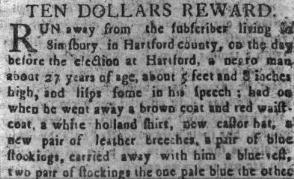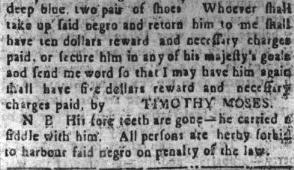Objects in the Dark, 1638-1775
Sons and Daughters of Africa |
|---|
For as nearly as long as there has
been this place called Hartford, the sons and daughters of Africa have labored. With their hands and
the sweat of their brows these first sable citizens hewed a place for themselves in this city by the
river. . .
![[sold]](sold.jpg) Colonial newspapers were read mainly by the "bourgeoisie." These owners of productive
property or people
licensed to provide socially valued services needed newspapers to learn about the marketplace in which
goods and services were bought and sold. In fact, much of what was printed in Colonial papers was news
of goods coming into ports or for sale, and, like today, newspapers contained little of the kind of
"news"
(information that serves as a basis for an informed public activity) that is a foundation of democracy. What
was important for the elite in this kind of society was the value of things in the marketplace, and this applied
to people as well. Here, for example, is a Hartford Courant notice of 24 May, 1773, concerning the availability
for sale of a 28-year old mother and her two sons. The owner claims he had too little use for them. He does
not include her husband in the offer so that she might remain with him.
Colonial newspapers were read mainly by the "bourgeoisie." These owners of productive
property or people
licensed to provide socially valued services needed newspapers to learn about the marketplace in which
goods and services were bought and sold. In fact, much of what was printed in Colonial papers was news
of goods coming into ports or for sale, and, like today, newspapers contained little of the kind of
"news"
(information that serves as a basis for an informed public activity) that is a foundation of democracy. What
was important for the elite in this kind of society was the value of things in the marketplace, and this applied
to people as well. Here, for example, is a Hartford Courant notice of 24 May, 1773, concerning the availability
for sale of a 28-year old mother and her two sons. The owner claims he had too little use for them. He does
not include her husband in the offer so that she might remain with him.
![[reward]](reward.jpg) Naturally, slaves ran away when they could, but the risks must have been enormous, and one expects
younger men were more likely to try it. Unlike today, in Colonial society one could not become socially
invisible by travelling elsewhere or by trying not to stand out, especially if you were Black. Here a 23-year
old "mulatto" (a person who is light-skinned because one of his or her parents was white), named Pero,
is being hunted down. This notice also includes an interesting description of how a slave might have dressed
in 1773. Probably the clothing description was not so much for identification as a listing of the property
that the slave owner would like to recover.
Naturally, slaves ran away when they could, but the risks must have been enormous, and one expects
younger men were more likely to try it. Unlike today, in Colonial society one could not become socially
invisible by travelling elsewhere or by trying not to stand out, especially if you were Black. Here a 23-year
old "mulatto" (a person who is light-skinned because one of his or her parents was white), named Pero,
is being hunted down. This notice also includes an interesting description of how a slave might have dressed
in 1773. Probably the clothing description was not so much for identification as a listing of the property
that the slave owner would like to recover.
![[advertisement for a breeder]](breeder.jpg) These sale advertisements are from the Connecticut Courant in 1773. Most slave sales were of
individuals, but occasionally a group would be sold. Young women were valued for their domestic skills, and
domestic employment remained typical of all Blacks, whether free or black, until the twentieth century
when wage labor opened new opportunities. Young women were also valued as "breeders," as in
this ad, probably because further slave imports to Connecticut were about to be prohibited.
These sale advertisements are from the Connecticut Courant in 1773. Most slave sales were of
individuals, but occasionally a group would be sold. Young women were valued for their domestic skills, and
domestic employment remained typical of all Blacks, whether free or black, until the twentieth century
when wage labor opened new opportunities. Young women were also valued as "breeders," as in
this ad, probably because further slave imports to Connecticut were about to be prohibited.


|
Here is another ten-dollar reward for the return of a young man. Again, the detailed description of
clothing may be as much to ensure a return of all property as to identify the escapee. The fact that
his front teeth are missing (the likely cause of his lisp), might suggest rough abuse, probably from his
owner. Perhaps this motivated his flight. He did take a violin with him, which indicates the importance
of musical culture in slave society. |
In 1690, the Colonial General Assembly passed a law that forbade
any "negro or mulatto servants/slaves to wander out of towne bounds without a pass from
master/mistress." Such a law hints that slaves were indeed roaming about on their own, perhaps with
escape in mind. The run-away slave announcements illustrated here from the Connecticut
Courant of 1774 and 1774 show that this continued to be a problem for the owners a century
later, perhaps because there were by this time significant Black communities in several Connecticut
towns that might provide refuge. On the other hand, the institution of Black Governers, to be discussed
later, would have made it difficult to remain hidden in any such a Black community.

![[Exhibit Contents]](../../bin/top.gif)
![[Back]](../../bin/back.gif)
![[Forward]](../../bin/forward.gif)
|